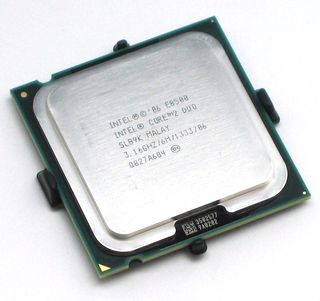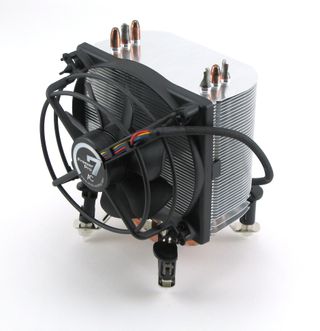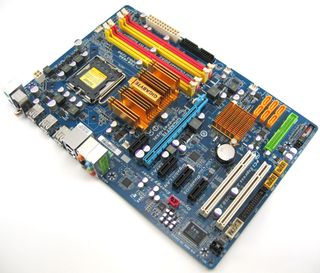Tom's Intl. $750 Cheap Computing Challenge
CPU, Cooler, And Motherboard
Processor: Intel Core 2 Duo E8500

Our first order of business was deciding which processor would offer the performance we desired without consuming excess power. The Intel Core 2 Duo 45nm Wolfdale chips looked to be attractive options, especially if we could get one with Intel's E0 stepping. The E8600 was a bit expensive for this budget, but fortunately it’s now common to find both an E8500 and E8400 with the stepping we wanted.
Clocked at 3.16 GHz with 6MB of L2 cache, the E8500 is no slouch at stock speeds. But our thinking was that these clock speeds could be pushed quite a bit higher without raising voltages--something we haven’t had much success doing with cheaper E7300 or E5200 Wolfdale CPUs.
CPU Cooler: Arctic Cooling Freezer 7 Pro

Without raising the processor voltage, we probably could have just used the retail Intel cooler, but priced at $19, the Arctic Cooling Freezer 7 Pro was easily within budget and has performed well in our recent budget systems. It has copper heatpipes, directs air out towards the rear case exhaust fan, and has a PWM variable speed 92 mm fan, which could save a bit of power consumption versus a fixed-speed fan.
Motherboard: Gigabyte GA-EP45-DS3L

In choosing the E8500, it was pretty much a given that we would use an affordable Intel P45 chipset motherboard. Offering stability, performance, and excellent overclocking abilities at an affordable price is reason alone to choose such a platform, but power consumption is also a key concern in this challenge. Unlike the P35, X38, and X48 chipsets, which are etched at 90 nm, the P45 is a 65 nm product, landing it at the top of our list.
We didn’t need a motherboard loaded with expensive energy-consuming features, so the affordable Gigabyte GA-EP45-DS3L, which has proven itself in the past couple System Builder Marathons, was chosen for this challenge as well. It uses Gigabyte’s Ultra Durable solid capacitor design, and comes packaged splashed with stickers promoting power efficiency features such as Dynamic 4-Gear power switching, a VRD 11.1 Design, and Dynamic Energy Saver Advanced technology.
Current page: CPU, Cooler, And Motherboard
Prev Page Introduction Next Page Memory, Graphics Card, And Hard DriveStay on the Cutting Edge
Join the experts who read Tom's Hardware for the inside track on enthusiast PC tech news — and have for over 25 years. We'll send breaking news and in-depth reviews of CPUs, GPUs, AI, maker hardware and more straight to your inbox.
-
xx12amanxx The Phenom 940 uses less power than your chosen cpu when cool and quiet is enabled at idle and it only cost's a tad bit more.Reply
Difference of opinion but i think quad's are now cheap enough that not considering one to get maximum life and performance is a bad mistake.
Dual''s will go the way of single cores soon.
-
kirvinb I totally agree with 12aman....the quads can outperform duals in anything that takes full advantage of their cores...pretty soo it will be everything!...8500 still is a good cpu...if you had to go dual i think that was the best choice...still you could of grabbed a amd 920 for under 200 now and get fantastic results.1Reply -
Noya This article it lame. The corporate world cares about server energy use, the home PC user/gamer could give a s**t.Reply -
Son_of_Blob This article is way past its use by date.Reply
What's needed now is a bang for buck review of a basic but powerful Core i7 versus Phenom II quad core rig....and then some game loving overclocks to see what can be done....with a comparison of stock coolers versus 3rd party air cooling too.
Something like this for the Intel side:
i7 920
Asus P6T non deluxe mobo (or decent equivalent).
3GB DDR3 triple channel Kingston Value RAM with XP Pro(not overpriced 6 GB on a Vista 64 bit OS..let's wait for Windows 7).
GTX260(216 version) or a 4870 1GB, say.
Decent 750watt PSU, i.e. a Zalman, to allow possible 2 way SLI or CF.
That's the current sweet spot for people on a budget who want to get the best way forward at the moment.
-
enewmen I don't know why THG uses Vista 32 so much?? Even 8 megs of DDR2-1066 RAM is getting cheap now.Reply
This makes me think 64 bit apps made to use more than 4 gigs won't take off for a LONG time or people just don't want it (like the new curved screen iPod).
I also agree with most posters the days of dual-cores are very limited even though most apps can't use 4 cores yet. Personally I think a cheap E0 Yorkfield or Phenom-II makes much more sense in this case..
1 TB hard-drive? I like big drives. But, that's 10x more storage than then average econo user will use. Unless future apps will actually efficiently use lots of drive space like the 64bit apps can address & use 8+ gigs of RAM.
SonOfBlob, it seems to me the Intel system your describing is will cost way more than $750. -
Why use the WD Green Drive? The WD Black or Hitachi 7K1000.B are much better choices for Mainstream/ all-round usage according to Tom’s Winter 2008 Hard Drive Guide. They both can be had for less than $115.Reply
-
Siffy Why use a rotating drive at all if performance + low power is the goal? An OCZ Core V2 or Solid would provide better throughput and access times for less than half the wattage draw of even a 5400rpm disk. And you can pick up a 60GB Solid forReply -
Onus Well Noya, I think that's a problem; people ought to care more. Just my opinion, but why pay for something you don't need? The choice to buy or build a low-energy PC is not an isolated decision; the same guy probably uses CFL bulbs, drives a fuel-efficient car (and doesn't take many short trips in it), keeps his thermostat on reasonable settings (75F in summer), runs only full loads of laundry, etc. Any one of those may not make a huge difference, but they add up.Reply -
pauldh xx12amanxxThe Phenom 940 uses less power than your chosen cpu when cool and quiet is enabled at idle and it only cost's a tad bit more.Difference of opinion but i think quad's are now cheap enough that not considering one to get maximum life and performance is a bad mistake.Dual''s will go the way of single cores soon.Phenom II's were not an option as component selections were prior to NDA and as a requirement needed to be readily available in retail.Reply
Other Quad core's in general were avoided for our system as looking over the benchmark suite, they just don't currently win enough to warrant the consumption. There will be no bonus points awarded for a possible advantage in future aps/benches. But, we'll soon find out if any of the other countries went the quad route.
For now, take a look back at this article.
http://www.tomshardware.com/reviews/e8500-phenom-9350e,2010.html
